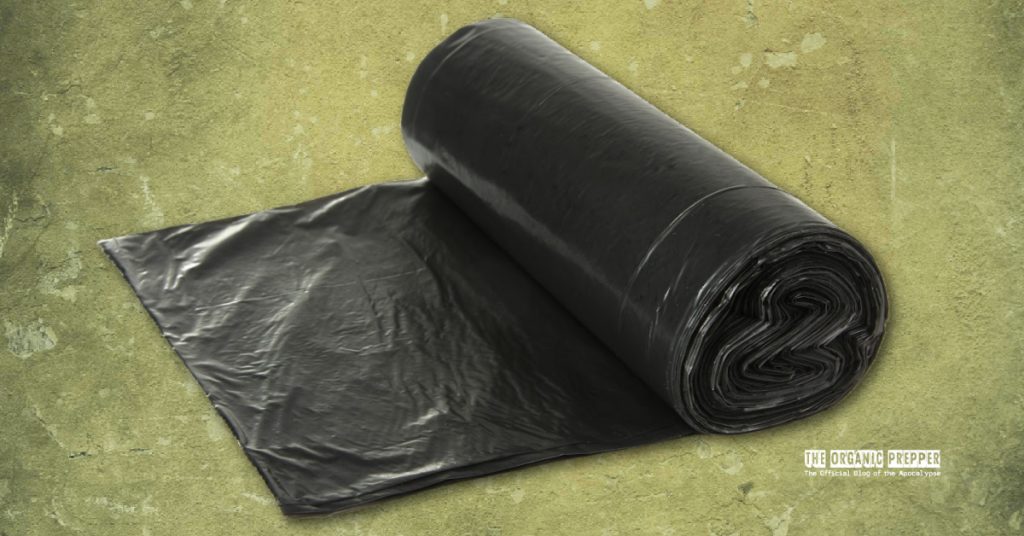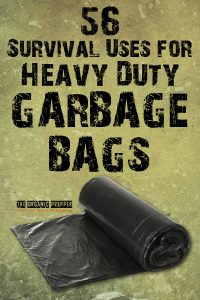If you're new here, you may want to subscribe to my RSS feed. Thanks for visiting!
In the world of preparedness, where adaptability and resourcefulness are the cornerstones of survival, there exists a humble yet indispensable item that often goes unnoticed: heavy-duty garbage bags. These unassuming giants of utility hold within their resilient confines a world of possibilities, proving time and again that they are an essential component of any prepper’s toolkit. From their fundamental role in waste management to their astonishing versatility in unforeseen circumstances, heavy-duty garbage bags are a prepper’s best-kept secret, ready to unveil a myriad of ingenious uses that can mean the difference between thriving and merely surviving in the face of adversity.
If you’re looking for a good brand, we recommend this one designed for contractors.
How can you use heavy-duty garbage bags for survival?
At first glance, these bags might seem like just another bag to take out the kitchen trash, albeit, with less chance of poking a hole. But their potential extends far beyond the realm of mere garbage disposal.
Below are 56 ways to use heavy-duty garbage bags. They truly are a Swiss Army knife for your prepper arsenal. These versatile bags are poised to tackle a wide array of challenges that might arise during times of crisis.
- Emergency shelter: Construct a makeshift tent or lean-to using garbage bags as the primary material.
- Ground cover: Lay them on the ground to keep moisture and cold away when sitting or sleeping. As it keeps the moisture away, it will also help to keep you warmer.
- Rain poncho: Create a simple rain poncho by cutting holes for your head and arms.
- Poncho for pets: Make ponchos for your pets to keep them dry in the rain.
- Wind protection: Hang bags as windbreaks to shield yourself from harsh winds.
- Water collection: Collect rainwater by creating a funnel system with bags.
- Food storage: Keep food items dry and protected from the elements.
- Laundry bag: Store and transport dirty clothes separately.
- Waterproofing: Line your backpack or boots to keep the contents dry.
- Floatation device: Inflate a bag to use as a buoyancy aid in water.
- Firewood transport: Gather and carry firewood easily.
- Trash compactor: Help reduce the volume of trash to minimize your footprint.
- Emergency water carrier: Transport water from a source to your campsite.
- Makeshift backpack: Secure bags to a stick or pole for carrying items, or make some makeshift straps with rope or cord.
- Emergency blanket: Reflect heat by wrapping yourself in a bag. While not ideal, it’s better than nothing!
- Gloves: Tie bags around your hands to protect them from cold or contamination.
- Foot coverings: Create temporary shoe covers to protect your feet, or wear them inside your shoes over your socks to prevent your feet or socks from getting damp.
- Sleeping bag liner: Insert one inside your sleeping bag for added warmth.
- Bandage cover: Use them as an extra barrier between a bandage or cast and the elements.
- Emergency rain tarp: Create a simple tarp shelter or ground cover.
- Trash disposal: Their primary purpose – to hold and transport trash.
- Trail markers: Use brightly colored bags to mark paths or trails.
- Quarantine area: Create a separate space for isolating sick individuals using bags and duct tape.
- Make a kitty litter toilet when a regular one isn’t an option.
- Plant protection: Cover plants during storms or adverse weather conditions.
- Pet care: Create a portable bedding or shelter solution for pets.
- Document protection: Safeguard important documents from water and debris.
- Stretcher: Reinforce with sticks to transport injured individuals.
- Sandbag barrier: Use them to create barriers against flooding.
- Emergency window covering: Seal broken windows or create a barrier against extreme temperatures.
- Storage for emergency gear: Keep emergency supplies organized and protected from dust and moisture.
- Protect furniture during painting: Cover furniture and flooring when painting or doing home improvements.
- Compost bin liner: Line your compost bin to make it easier to empty and clean.
- Weed barrier: Place bags under mulch or soil to prevent weeds from sprouting.
- Garden soil transport: Move soil, mulch, or compost around the garden without making a mess.
- Rain barrel cover: Keep debris, insects, and contaminants out of your rainwater harvesting system.
- Seed starter greenhouse: Create a mini greenhouse by covering seedlings with clear bags to promote germination.
- Emergency insulation: Fill bags with leaves or other insulating material to improve home insulation temporarily.
- Protect outdoor furniture: Cover patio furniture during bad weather or the off-season.
- Emergency roof patch: Temporarily patch a leaking roof until repairs can be made.
- Emergency rain gear: Keep a few bags on hand for makeshift rain gear when unexpected rain strikes.
- Emergency sleeping mat: Fill a bag with leaves or insulation material for additional insulation under your sleeping bag.
- Seat protection: Cover car seats with bags to keep them clean when transporting dirty or wet items.
- Windshield cover: Prevent frost or snow buildup on your windshield during cold weather.
- Protect luggage: Use bags to protect luggage from rain or dust during travel.
- Emergency windshield or window repair: Use a bag as a temporary seal for a cracked windshield or window. (Make sure that if you are still driving your car, the bag does not obstruct your vision.)
- Leak containment: Place bags under leaking containers to prevent spills from spreading.
- Warming up water: Fill bags with water, place them in the sun to heat, and you’ll have warm water for washing.
- Privacy barrier: Create a makeshift privacy curtain for changing or sleeping in your car.
- Windproof layer: Layer bags underneath your clothing to act as a wind barrier.
- Snow gaiters: Wrap bags around your ankles to keep snow out of your boots.
- Snowshoe bindings: Create bindings for improvised snowshoes by securing bags to your footwear.
- Make a balaclava: Cut and shape a bag to create a balaclava for face and neck protection.
- Snow shelter: Fill bags with snow to build walls or insulating layers for a snow shelter.
- Snow and ice traction: Cut bags into strips and place them under your shoes for improved traction on icy surfaces.
- Emergency sled: Use bags as an improvised sled on snowy terrain.
One thing to remember
While all garbage bags can be useful, it’s the heavy-duty ones that will give you the most benefits and something that you don’t want to skimp out on. You want a bag designed for contractors like this one.
While the strong ones aren’t needed for your basic household garbage, in an emergency situation, it can make a world of difference.
How do you use heavy-duty garbage bags?
With so many uses, I feel like this list could go on forever! What are your go-to uses for heavy-duty garbage bags? Will you be adding them to your bug-Out bags? Was there anything on this list that you hadn’t thought of?
Let’s discuss this in the comments!
About Chloe Morgan
Chloe Morgan grew up living with a tight budget in a prepper household. Chloe lives in Northern Ontario, Canada, with her dog, Rhea.
Check out her work on TheOrganicPrepper.com and TheFrugalite.com where she writes about food, frugality, finances, and self-reliance, or her work on Medium, where she writes about lifestyle, mental health, and writing.

















7 Responses
For anything food-related, especially water, make sure the bags do not have any ‘anti-‘ properties. Bags that have insecticides, odor control, and the like should never be used for food items. The same can be said, to a lesser, though still important degree, for any uses where you might be inhaling air through, over, or across the bags. You do not want those fumes in your lungs.
I lucked into a plethora of legal 4- and 6-gallon milk jug crates. They are great for many things, but nothing very small as those items will go right through the webbing. I use the 42-gallon contractor bags to line the crates to keep things inside. The black bags makes it very dark inside the crates so when I get ahold of a copy paper box I put the empty box in one of the crates inside the trash bag and the lid inside another one. It prevents wrinkles that can hide small stuff as well as makes things brighter inside so they are easier to see.
I did notice that several things on the list were essentially duplicates with only minor variations in the uses. Still, I have to say, when I started using the bags several years ago I seem to keep finding another use every few months.
Get them now while still available and keep them stored in cool, dry environment.
Just my opinion.
they are a good size to carry because they are not too big and the ones I obtained have nice handles that don’t cut into your hands. I found mine tossed out lying next to the dumpster at a gas station. a good place to keep your eyes open for things that get tossed — like shelving–. good post Jerry——– I, Grampa
If your bags do have “anti” properties turn them inside out. Probably still not the best, but it will help.
If possible get the clear garbage bags rather than the black ones. Clear ones will allow sunlight (UV rays) to penetrate the garbage bags and can be used to help purify water.
Great list!
Also…
Potatoes (or similar) grow bag….double or triple them up and add drainage holes and support, depending on your set up.
Garden shade cloth (in my climate you need this) or emergency drip watering system…a bag with a hole in it.
sewing the bags between two lightweight blankets provides the layer that stops body heat loss. it raises the humidity content of the air that traps heat. While we didn’t have the garbage bags when I was small my dad brought home the packaging used for shipping to job sites. it was heavier but when you didn’t have heat in your bedroom it kept you warm. I learned how to speed dress and get downstairs where the heat was. all we had for floor covering was linoleum. we didn’t have central heat so we had plenty of handmade blankets to keep warm.——– I, Grampa
You can also buy the 6 mil on Amazon. If you’re getting them for an emergency other than trash, it’s worth even though they cost more.
Stretch across window leaving apace between the plastic and the glass. Also leave a gap at the top and bottom. The bag will act as a simple solar room heater on sunny days.